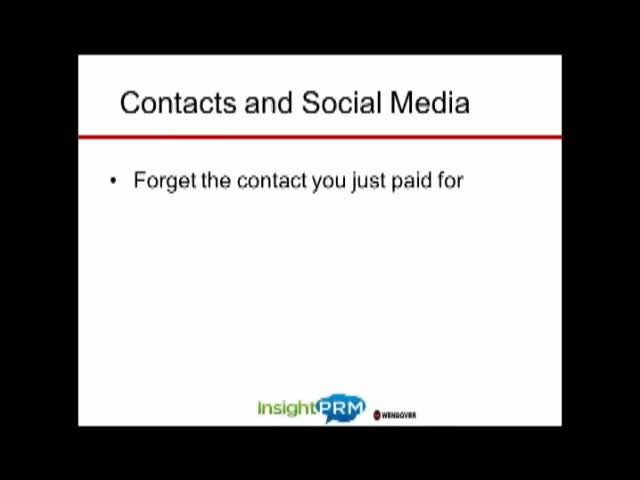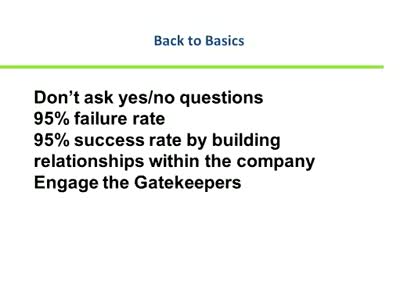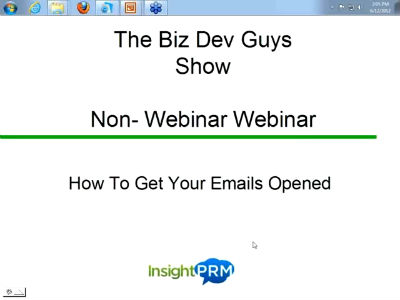Are you killing deals from poor lead conversion?
By: Larry Dillon
Are you killing deals from poor lead conversion?
75% of disqualified leads are actually qualified and go on to purchase from a competitor.
This is the result of an in-depth survey of 450 disqualified leads provided to us by dozens of suppliers. What is killing your conversion rate? The challenge is that from 30 years of research into this problem, there is not just a few key problems, there are many issues at hand. First you have to look at the buyer. It is the buyers process that is important. The buyers process must be looked at first, and then you can develop your selling process from there. It’s easy to try and develop a selling process in a vacuum and try to shove that on your buyers. It does not usually end well. For the scope of this article, we are going to explore the first part of the selling process — converting a lead into an appointment. This is the part of the sales process that most companies give themselves a failing grade.
The challenge when you have a lead is that you are not dealing with one type of buyer, you are dealing with buyers that look at the purchasing process in many ways. It’s important to understand a few facts about buyers.
- Buyers do not have to be responsive
- Buyers are liars
- Buyers prefer a prescriptive sales approach
Buyers don’t have to be responsive. Every month my team will close deals from a web lead that filled out the form on our website. They request a salesperson to call them and give us their phone number and email address. We typically respond in less than 2 minutes to these requests. The interesting part is that we are unable to get the person on the phone for many of these leads. Even though we call back in less than 2 minutes. We always send an email as well. And again, in many of these cases, no response to the email or phone call and no call backs. It typically takes one call back each day for the first 5 business days to get the person on the phone. One of our top 10 deals took 18 unanswered follow ups over 90 days to get the person on the phone. Once we got them on the phone, the deal closed in less than 5 days. If we had not done this kind of follow up, they would have taken their business elsewhere. Our most successful clients have shared many similar cases of very large deals that took over a dozen follow ups to get the prospect on the phone to set the appointment. The research is clear. These days it takes an average of 10 unanswered follow up calls to get an interested buyer on the phone. So, don’t associate unresponsiveness with a lack of interest. Buyers are overwhelmed these days. They tend to procrastinate so make sure your lead nurturing process takes this into account.
Buyers are suffering from information overload. HBR recently reported when refereeing to buyers, “Customers are increasingly overwhelmed and often more paralyzed than empowered”. There is so much information online that it’s difficult for buyers to process all the information. It’s also difficult for sellers to know what has influenced the buyers process. A buyer may be influenced by information on the internet that is not correct. This can be a big challenge. That’s why it’s more important these days to attempt two things:
- Get in front of the prospect as early as possible before they have formulated their buying process.
- Ask the buyer how they are going to decide on a supplier. What is most important to them?
Buyers are liars. This is the easiest thing to counteract, yet, most sellers fall prey to this trap. Let’s go through one real life example. We had a customer who sold office furniture in Cleveland. He called us one day and said, “I just closed one of the biggest deals of my career from one of your leads”. I called this company 5 time before I got the appointment. The interesting thing was in the first 4 calls the prospect said, ‘I am not moving; I am not buying any furniture’. We asked, “why did you keep calling when the lead clearly looked like it was disqualified”? He said a year prior he got a lead from us and the prospect told them they where not moving. Six months later, he saw three large trucks belonging to his direct competitor unloading new office furniture to a downtown building. If you’re in that business and you see your competitors unloading a large order, you stop and ask for the name of the company that the furniture is being delivered to. We all hate losing deals. Well, this mover asked for the name of the customer. It was the prospect that had told them they were not moving or buying furniture 6 months prior. He told us since then he does not believe the prospect and had tripled the results he gets from all leads. This is NOT an isolated case. The top inside sales reps in every industry we have worked with all have similar stories. In fact, over half report closing a top 10 all time deal from a buyer that was initially a liar.
Prescriptive selling
As we mentioned earlier, customers are overwhelmed with the information available to them when buying products and services. It stresses them and can cause them to be overwhelmed. There has been a big push lately for the responsive sales approach. That is providing customers with useful content to guide them through the sales process. We have all heard the stat over and over that customers are doing their research online and that 80% of the decision-making process is completed before they speak to a salesperson. So, companies have been publishing piles of content online and waiting for customers to approach them. In a recent article published in the Harvard Business Review “The New Sales Imperative”, they report, “in fact this “responsive“ sales approach has the opposite effect, decreasing the likeliness of purchase ease and increasing the likeliness of purchase regret”. One of the major problems we see with the responsive approach is that because there is no direct communication with the prospect, you have no idea what other content the buyers are reading. Does that content contradict yours? Is the content accurate? Does this content diminish the perceived value of your brand? On top of that, buyers report being overwhelmed with content making the process “stressful” and “painful”. The article states that, ”not surprisingly, customers perceive prescriptive salespeople as being one step ahead, anticipating and eliminating obstacles”. The objective is to understand the customers business and prescribe the perfect solution. Gary Pica from True Methods in an article entitled “Are You Setting Landmines for Your Competition?” writes, “be strategic and identify emotional pain. Your goal when meeting with the prospect is to control the sales process every step of the way. This is especially important when they’re also engaged with your competitors.” “Here’s the thing: You learn where your prospects are in the process by simply asking them early on often”. “If you don’t ask, you will get burned down the road”. This is why it is so important to engage the client early in the process. You need to get a meeting with them. Unless you meet with the customer, it’s nearly impossible to identify their pain or understand their business. This is the big problem with just pumping out a ton of content. Let’s put it this way, if I get in front of the customer much earlier than my competition, I am going to find their pain, understand their business, and construct a solution that is perfect for them. I will propose a solution that addresses all their pains and makes it easy for the buyer to say yes. At this point, I am perceived as a consultant to trust and can build a narrative that makes my competition irrelevant before they ever speak to the client. The key to achieving this position is becoming an expert at converting leads into appointments because until you get an appointment, it’s almost impossible to understand their pain, their business and build trust. Your goal should be to convert leads into appointments much earlier than your competition. The opportunity here is that lead conversion is your competitors admitted greatest weakness in their sales process. In a survey of sales managers, salespeople, and business owners, we asked to grade themselves in their ability to consistently convert leads into appointments on a scale of 1 to 100. The average score was 58, a failing grade. What’s more, we asked them to grade themselves on five other aspects of the sales process. Lead conversion was the only failing grade they gave themselves. Work hard to understand the challenges of lead nurturing, build a strong effective process, have the pig-headed determination to implement it and you will dominate your marketplace.









